Models for Predicting Specific Gravity and Ring Width for Loblolly Pine from Intensively Managed Plantations, and Implications for Wood Utilization
Abstract
:1. Introduction
2. Materials and Methods
2.1. Sample Origin
2.2. X-ray Densitometry
2.3. Data Analysis
2.4. Specific Gravity Model Development
2.5. Ring Width Model Development
2.6. Latewood- and Earlywood-Specific Gravity Model Development
2.7. Latewood Percent Model Development
2.8. Tree Map Development
2.9. Average Tree- and Log-Specific Gravity and Proportion of Corewood throughout Rotation
3. Results
4. Discussion
5. Conclusions
Author Contributions
Funding
Acknowledgments
Conflicts of Interest
References
- Sedjo, R.A. The role of forest plantations in the world’s future timber supply. For. Chron. 2001, 77, 221–225. [Google Scholar] [CrossRef]
- Sedjo, R.A. The potential of high-yield plantation forestry for meeting timber needs. New For. 1999, 17, 339–359. [Google Scholar] [CrossRef]
- FAO. Global Forest Resources Assessment 2005, Main Report. Progress towards Sustainable Forest Management; FAO Forestry Paper 147; FAO: Rome, Italy, 2006. [Google Scholar]
- Wear, D.N.; Greis, J.G. Southern Forest Resource Assessment: Summary of Findings. J. For. 2002, 100, 6–14. [Google Scholar]
- McKeand, S.; Mullin, T.; Bryam, T.; White, T. Deployment of genetically improved loblolly and slash pines in the South. J. For. 2003, 101, 32–37. [Google Scholar]
- Borders, B.E.; Bailey, R.L. Loblolly pine—Pushing the limits of growth. South. J. Appl. For. 2001, 25, 69–74. [Google Scholar]
- Fox, T.R.; Jokela, E.J.; Allen, H.L. The development of pine plantation silviculture in the southern United States. J. For. 2007, 105, 337–347. [Google Scholar]
- Zhao, D.; Kane, M.B.; Teskey, R.O.; Fox, T.R.; Albaugh, T.J.; Allen, H.L.; Rubilar, R.A. Maximum response of loblolly pine plantations to silvicultural management in the southern United States. For. Ecol. Manag. 2016, 375, 105–111. [Google Scholar] [CrossRef]
- Clark, A., III; Jordan, L.; Schimleck, L.; Daniels, R.F. Effect of initial planting spacing on wood properties of unthinned loblolly pine at age 21. For. Prod. J. 2008, 58, 78–83. [Google Scholar]
- Burdon, R.D.; Kibblewhite, R.P.; Walker, J.C.F.; Megraw, R.A.; Evans, R.; Cown, D.J. Juvenile versus mature wood: A new concept, orthogonal to corewood versus outerwood, with special reference to Pinus radiata and P-taeda. For. Sci. 2004, 50, 399–415. [Google Scholar]
- Moore, J.R.; Cown, D.J. Corewood (juvenile wood) and its impact on wood utilisation. Curr. For. Rep. 2017, 3, 107–119. [Google Scholar] [CrossRef]
- Lachenbruch, B.; Moore, J.R.; Evans, R. Radial variation in wood structure and function in woody plants, and hypotheses for its occurrence. In Size- and Age-Related Changes in Tree Structure and Function; Meinzer, F.C., Lachenbruch, B., Dawson, T.E., Eds.; Springer: Berlin, Germany, 2011; pp. 121–164. [Google Scholar]
- Larson, P.R.; Kretschmann, D.E.; Clark, A., III; Isebrands, J.G. Formation and Properties of Juvenile Wood in Southern Pines; FPL-TR-129; US for Serv. Forest Products Laboratory: Madison, WI, USA, 2001. [Google Scholar]
- Ying, L.; Kretschmann, D.E.; Bendtsen, B.A. Longitudinal shrinkage in fast-grown loblolly pine wood. For. Prod. J. 1994, 44, 58–62. [Google Scholar]
- Jordan, L.; He, R.; Hall, D.B.; Clark, A., III; Daniels, R.F. Variation in loblolly pine ring microfibril angle in the Southeastern United States. Wood Fiber Sci. 2007, 39, 352–363. [Google Scholar]
- Clark, A., III; Daniels, R.F.; Jordan, L. Juvenile/mature wood transition in loblolly pine as defined by annual ring specific gravity, proportion of latewood, and microfibril angle. Wood Fiber Sci. 2006, 38, 292–299. [Google Scholar]
- Butler, A.; Dahlen, J.; Daniels, R.F.; Eberhardt, T.L.; Antony, F. Bending strength and stiffness of loblolly pine lumber from intensively managed stands located on the Georgia Lower Coastal Plain. Eur. J. Wood Prod. 2016, 47, 91–100. [Google Scholar] [CrossRef]
- Hoag, M.; McKimmy, M.D. Direct scanning X-ray densitometry of thin wood sections. For. Prod. J. 1988, 38, 23–26. [Google Scholar]
- Xiang, W.; Leitch, M.; Auty, D.; Duchateau, E.; Achim, A. Radial trends in black spruce wood density can show an age- and growth-related decline. Ann. For. Sci. 2014, 71, 603–615. [Google Scholar] [CrossRef]
- Jacquin, P.; Longuetaud, F.; Leban, J.M.; Mothe, F. X-ray microdensitometry of wood: A review of existing principles and devices. Dendrochronologia 2017, 42, 42–50. [Google Scholar] [CrossRef]
- Evans, R.; Stuart, S.A.; Van Der Touw, J. Microfibril angle scanning of increment cores by X-ray diffractometry. Appita J. 1996, 6, 411–414. [Google Scholar]
- Evans, R.; Hughes, M.; Menz, D. Microfibril angle variation by scanning X-ray diffractometry. Appita J. 1999, 5, 363–367. [Google Scholar]
- Donaldson, L.L. Microfibril angle: Measurement, variation and relationships—A review. IAWA J. 2008, 4, 345–386. [Google Scholar] [CrossRef]
- Hirn, U.; Bauer, W. A review of image analysis based methods to evaluate fiber properties. Lenzing. Ber. 2006, 86, 96–105. [Google Scholar]
- Chen, Z.Q.; Karlsson, B.; Mӧrling, T.; Olsson, L.; Mellerowicz, E.J.; Wu, H.X.; Lundqvist, S.O.; Gil, M.R.G. Genetic analysis of fiber dimensions and their correlation with stem diameter and solid-wood properties in Norway spruce. Tree Genet. Genomes 2016, 12, 123. [Google Scholar] [CrossRef]
- Evans, R. Rapid measurement of the transverse dimensions of tracheids in radial wood sections from Pinus radiata. Holzforschung 1994, 48, 168–172. [Google Scholar] [CrossRef]
- Chen, F.; Evans, R. A robust approach for vessel identification and quantification in eucalypt pulpwoods. IAWA J. 2005, 6, 442–447. [Google Scholar]
- Vahey, D.W.; Zhu, J.Y.; Scott, C.T. Wood density and anatomical properties in suppressed-growth trees: Comparison of two methods. Wood Fiber Sci. 2007, 39, 462–471. [Google Scholar]
- So, C.L.; Via, B.K.; Groom, L.H.; Schimleck, L.R.; Shupe, T.F.; Kelley, S.S.; Rials, T.G. Near infrared spectroscopy in the forest products industry. For. Prod. J. 2004, 54, 7–16. [Google Scholar]
- Tsuchikawa, S.; Kobori, H. A review of recent application of near infrared spectroscopy to wood science and technology. J. Wood Sci. 2015, 61, 213–220. [Google Scholar] [CrossRef]
- Nabavi, M.; Dahlen, J.; Schimleck, L.; Eberhardt, T.L.; Montes, C. Regional calibration models for predicting loblolly pine tracheid properties using near-infrared spectroscopy. Wood Sci. Technol. 2018, 52, 445–463. [Google Scholar] [CrossRef]
- Huang, C.-L.; Lindström, H.; Nakada, R.; Ralston, J. Cell wall structure and wood properties determined by acoustics—A selective review. Holz Roh Werkstoff 2003, 61, 321–335. [Google Scholar] [CrossRef]
- Mason, E.G.; Hayes, M.; Pink, N. Validation of ultrasonic velocity estimates of wood properties in discs of radiata pine. N. Z. J. For. Sci. 2017, 47, 16. [Google Scholar] [CrossRef]
- Hasegawa, M.; Takata, M.; Matsumura, J.; Oda, K. Effect of wood properties on within-tree variation in ultrasonic wave velocity in softwood. Ultrasonics 2010, 51, 296–302. [Google Scholar] [CrossRef] [PubMed]
- Hasegawa, M.; Mori, M.; Matsumura, J. Relations of fiber length to within-tree variation of ultrasonic wave velocity in fast-growing trees. Wood Fiber Sci. 2015, 3, 1–6. [Google Scholar]
- Riddell, M.; Cown, D.; Harrington, J.; Lee, J.; Moore, J. Assessing spiral grain angle by light transmission—Proof of concept. IAWA J. 2012, 33, 1–14. [Google Scholar] [CrossRef]
- Moore, J.R.; Cown, D.J.; McKinley, R.B. Modelling spiral grain angle variation in New Zealand-grown radiata pine. N. Z. J. For. Sci. 2015, 45, 15. [Google Scholar] [CrossRef]
- Auty, D.; Achim, A.; Macdonald, E.; Cameron, A.D.; Gardiner, B.A. Models for predicting wood density variation in Scots pine. Forestry 2014, 87, 449–458. [Google Scholar] [CrossRef]
- Kimberley, M.O.; Cown, D.J.; McKinley, R.B.; Moore, J.R.; Dowling, L.J. Modelling the variation in wood density within and among trees in stands of New Zealand-grown radiata pine. N. Z. J. For. Sci. 2015, 45, 22. [Google Scholar] [CrossRef]
- McLean, J.P.; Moore, J.R.; Gardiner, B.A.; Lee, S.J.; Mochan, S.J.; Jarvis, M.C. Variation of radial wood properties from genetically improved Sitka spruce growing in the UK. Forestry 2016, 89, 109–116. [Google Scholar] [CrossRef]
- Kimberley, M.O.; McKinley, R.B.; Cown, D.J.; Moore, J.R. Modelling the variation in wood density of New Zealand-grown Douglas-fir. N. Z. J. For. Sci. 2017, 47, 15. [Google Scholar] [CrossRef]
- Megraw, R.A. Wood Quality Factors in Loblolly Pine; TAPPI: Peachtree Corners, GA, USA, 1985; p. 88. [Google Scholar]
- Downes, G.M.; Drew, D.; Battaglia, M.; Schulze, D. Measuring and modelling stem growth and wood formation: An overview. Dendrochronologia 2009, 27, 147–157. [Google Scholar] [CrossRef]
- Briggs, D.G. Enhancing forest value productivity through fiber quality. J. For. 2010, 108, 174–182. [Google Scholar]
- Burkhart, H.E.; Tomé, M. Modeling Forest Trees and Stands; Springer: Berlin, Germany, 2012; pp. 405–427. ISBN 978-90-481-3170-9. [Google Scholar]
- Antony, F.; Jordan, L.; Schimleck, L.R.; Daniels, R.F.; Clark, A., III. The effect of mid-rotation fertilization on the wood properties of loblolly pine (Pinus taeda). IAWA J. 2009, 30, 49–58. [Google Scholar] [CrossRef]
- Love-Myers, K.R.; Clark, A., III; Schimleck, L.; Jokela, E.J.; Daniels, R.F. Specific gravity responses of slash pine and loblolly pine following mid-rotation fertilization. For. Ecol. Manag. 2009, 257, 2342–2349. [Google Scholar] [CrossRef]
- Love-Myers, K.R.; Clark, A., III; Schimleck, L.R.; Dougherty, P.M.; Daniels, R.F. The effects of irrigation and fertilization on specific gravity of loblolly pine. For. Sci. 2010, 56, 484–493. [Google Scholar]
- Clark, A., III; Borders, B.E.; Daniels, R.F. Impact of vegetation control and annual fertilization on properties of loblolly pine wood at age 12. For. Prod. J. 2004, 54, 90–96. [Google Scholar]
- Antony, F.; Schimleck, L.R.; Jordan, L.; Hornsby, B.; Dahlen, J.; Daniels, R.F.; Clark, A., III; Apiolaza, L.A.; Huber, D. Growth and wood properties of genetically improved loblolly pine: Propagation type comparison and genetic parameters. Can. J. For. Res. 2014, 44, 263–272. [Google Scholar] [CrossRef]
- Filipescu, C.N.; Stoehr, M.U.; Pigott, D.R. Variation of lumber properties in genetically improved full-sib families of Douglas-fir in British Columbia, Canada. Forestry 2018, 91, 320–326. [Google Scholar] [CrossRef]
- Butler, A.; Dahlen, J.; Eberhardt, T.L.; Montes, C.; Antony, F.; Daniels, R.F. Acoustic evaluation of loblolly pine tree- and lumber-length logs allows for segregation of lumber modulus of elasticity, not for modulus of rupture. Ann. For. Sci. 2017, 74, 20. [Google Scholar] [CrossRef]
- Dahlen, J.; Montes, C.; Eberhardt, T.L.; Auty, D. Probability models that relate nondestructive test methods to lumber design values of plantation loblolly pine. Forestry 2018, 91, 295–306. [Google Scholar] [CrossRef]
- ASTM International. ASTM D2395–17: Standard Test Methods for Density and Specific Gravity (Relative Density) of Wood and Wood-Based Materials; ASTM International: West Conshohocken, PA, USA, 2017. [Google Scholar]
- Antony, F.; Schimleck, L.R.; Daniels, R.F. A comparison of earlywood-latewood demarcation methods—A case study in loblolly pine. IAWA J. 2012, 33, 187–195. [Google Scholar]
- Eberhardt, T.L.; Samuelson, L.J. Collection of wood quality data by X-ray densitometry: A case study with three southern pines. Wood Sci. Technol. 2015, 49, 739–753. [Google Scholar] [CrossRef]
- R Core Team. R: A Language and Environment for Statistical Computing. R Foundation for Statistical Computing, Vienna, Austria. 2018. Available online: http://www.R-project.org/ (accessed on 18 April 2018).
- RStudio. RStudio: Integrated Development Environment for R. Boston, MA. 2018. Available online: https://www.rstudio.com/ (accessed on 18 April 2018).
- Wickham, H.; Francois, R. dplyr: A Grammar of Data Manipulation. 2017. R Package Version 0.7.4. Available online: https://CRAN.R-project.org/package=dplyr (accessed on 18 April 2018).
- Rigby, R.A.; Stasinopoulos, D.M. Generalized additive models for location, scale and shape, (with discussion). Appl. Stat. 2005, 54, 507–554. [Google Scholar] [CrossRef]
- Wickham, H. ggplot2: Elegant Graphics for Data Analysis; Springer: New York, NY, USA, 2009; p. 212. [Google Scholar]
- Auguie, B. gridExtra: Miscellaneous Functions for “Grid” Graphics. 2016. R Package Version 2.2.1. Available online: https://CRAN.R-project.org/package=gridExtra (accessed on 18 April 2018).
- Pebesma, E.J. Multivariable geostatistics in S: The gstat package. Comput. Geosci. 2004, 30, 683–691. [Google Scholar] [CrossRef]
- Gräler, B.; Pebesma, E.; Heuvelink, G. Spatio-temporal interpolation using gstat. R J. 2016, 8, 204–218. [Google Scholar]
- Pinheiro, J.; Bates, D.; DebRoy, S.; Sarkar, D.; R Core Team. nlme: Linear and Nonlinear Mixed Effects Models. 2016. R Package Version 3.1–128. Available online: https://CRAN.R-project.org/package=nlme (accessed on 18 April 2018).
- Hijmans, R.J. Raster: Geographic Data Analysis and Modeling. 2016. R Package Version 2.5–8. Available online: https://CRAN.R-project.org/package=raster (accessed on 18 April 2018).
- Baddeley, A.; Rubak, E.; Turner, R. Spatial Point Patterns: Methodology and Applications with R; Chapman and Hall/CRC Press: London, UK, 2016; p. 810. ISBN 9781482210200. [Google Scholar]
- Ratkowsky, D.A. Handbook of Nonlinear Regression Models; Marcel Dekker: New York, NY, USA, 1990; p. 241. [Google Scholar]
- Mora, C.R.; Allen, H.L.; Daniels, R.F.; Clark, A., III. Modeling corewood-outerwood transition in loblolly pine using wood specific gravity. Can. J. For. Res. 2007, 37, 999–1011. [Google Scholar] [CrossRef]
- Antony, F.; Schimleck, L.R.; Jordan, L.; Clark, A., III; Daniels, R.F. Effect of early age woody and herbaceous competition control on wood properties of loblolly pine. For. Ecol. Manag. 2011, 262, 1639–1647. [Google Scholar] [CrossRef]
- Tasissa, G.; Burkhardt, H.E. Modeling thinning effects on ring width distribution in loblolly pine (Pinus taeda). Can. J. For. Res. 1997, 27, 1291–1301. [Google Scholar] [CrossRef]
- Gardiner, B.; Berry, P.; Moulia, B. Review: Wind impacts on plant growth, mechanics and damage. Plant Sci. 2016, 245, 94–118. [Google Scholar] [CrossRef] [PubMed]
- Ospina, R.; Ferrari, S.L. A general class of zero-or-one inflated beta regression models. Comput. Stat. Data Anal. 2012, 56, 1609–1623. [Google Scholar] [CrossRef]
- Mora, C.R.; Schimleck, L.R. Determination of within-tree variation of Pinus taeda wood properties by near infrared spectroscopy. Part 2: Whole-tree wood property maps. Appita 2009, 62, 232–238. [Google Scholar]
- Diéguez-Aranda, U.; Burkhardt, H.E.; Amateis, R.L. Dynamic site model for loblolly pine (Pinus taeda L.) plantations in the United States. For. Sci. 2006, 52, 262–272. [Google Scholar]
- Bullock, B.P.; Burkhart, H.E. Equations for predicting green weight of loblolly pine trees in the south. South. J. Appl. For. 2001, 27, 153–159. [Google Scholar]
- Jordan, L.; Clark, A., III; Schimleck, L.R.; Hall, D.; Daniels, R.F. Regional variation in wood specific gravity of planted loblolly pine in the United States. Can. J. For. Res. 2008, 38, 698–710. [Google Scholar] [CrossRef]
- Antony, F.; Schimleck, L.R.; Hall, D.B.; Clark, A., III; Daniels, R.F. Modeling the effect of midrotation fertilization on specific gravity of loblolly pine (Pinus taeda L.). For. Sci. 2011, 57, 145–152. [Google Scholar]
- Kibblewhite, R.P. Designer fibres for improved papers through exploiting variations in wood microstructure. Appita J. 1999, 52, 429–435,440. [Google Scholar]
- MacDonald, E.; Gardiner, B.; Mason, W. The effects of transformation of even-aged stands to continuous cover forestry on conifer log quality and wood properties in the UK. Forestry 2009, 83, 1–16. [Google Scholar] [CrossRef]
- Longuetaud, F.; Mothe, F.; Fournier, M.; Dlouha, H.; Santenoise, P.; Deleuze, C. Within-stem maps of wood density and water content for characterization of species: A case study on three hardwood and two softwood species. Ann. For. Sci. 2016, 73, 601–614. [Google Scholar] [CrossRef]
- Koubaa, A.; Tony Zhang, S.Y.; Makni, S. Defining the transition from earlywood to latewood in black spruce based on intra-ring wood density profiles from X-ray densitometry. Ann. For. Sci. 2002, 59, 511–518. [Google Scholar] [CrossRef]
- Antony, F.; Schimleck, L.R.; Daniels, R.F.; Clark, A., III; Hall, D.B. Modeling the longitudinal variation in wood specific gravity of planted loblolly pine (Pinus taeda) in the United States. Can. J. For. Res. 2010, 40, 2439–2451. [Google Scholar] [CrossRef]
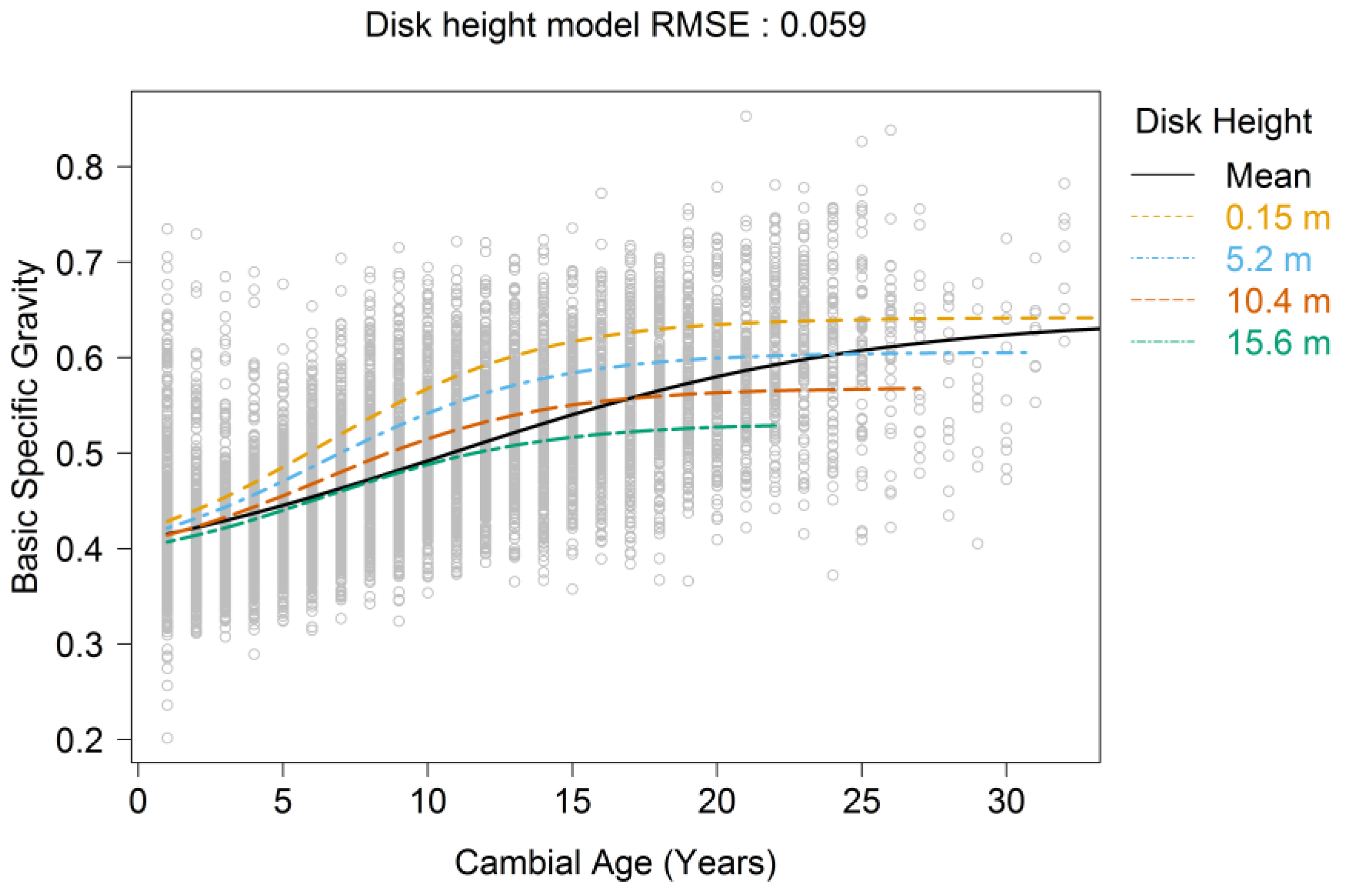
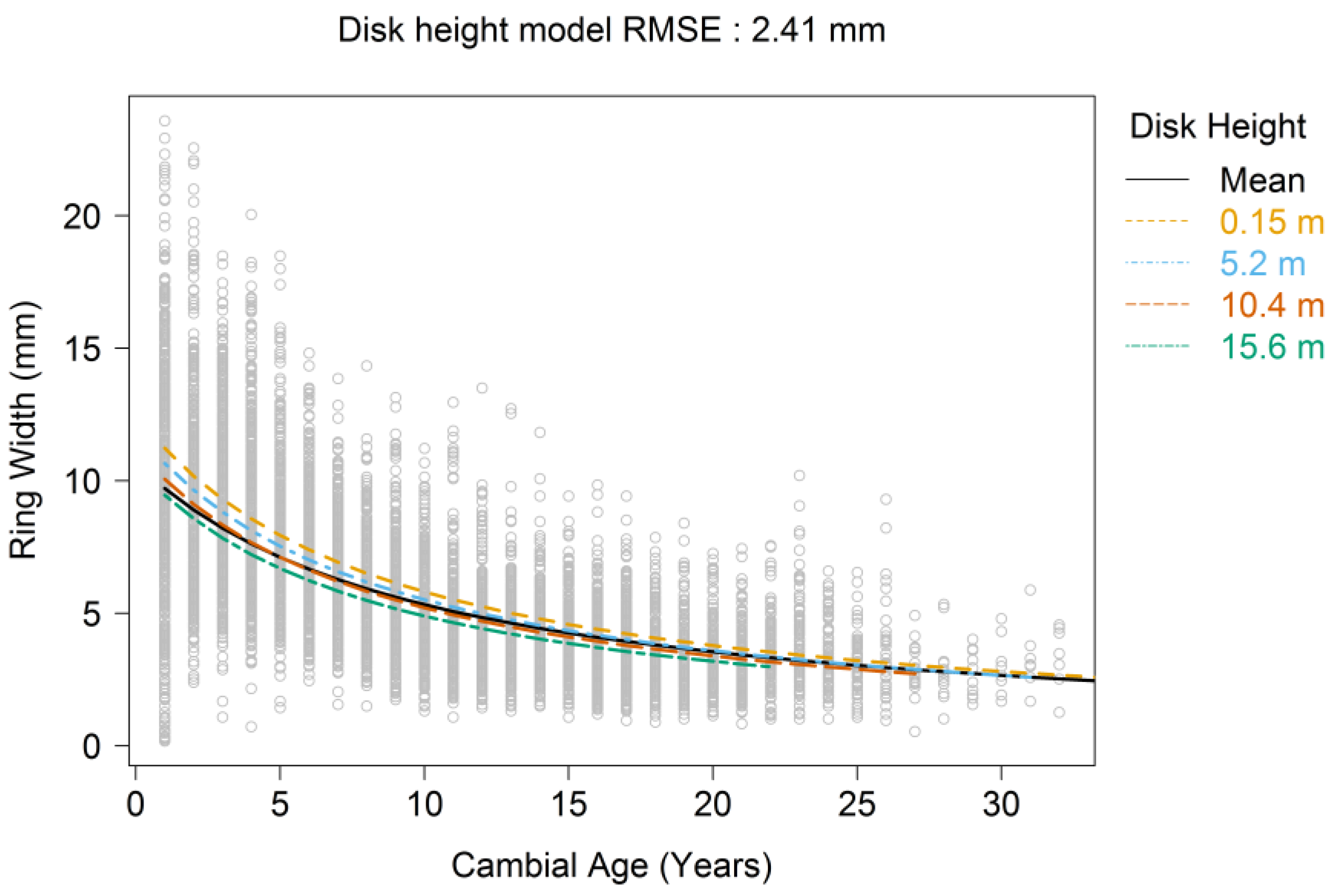
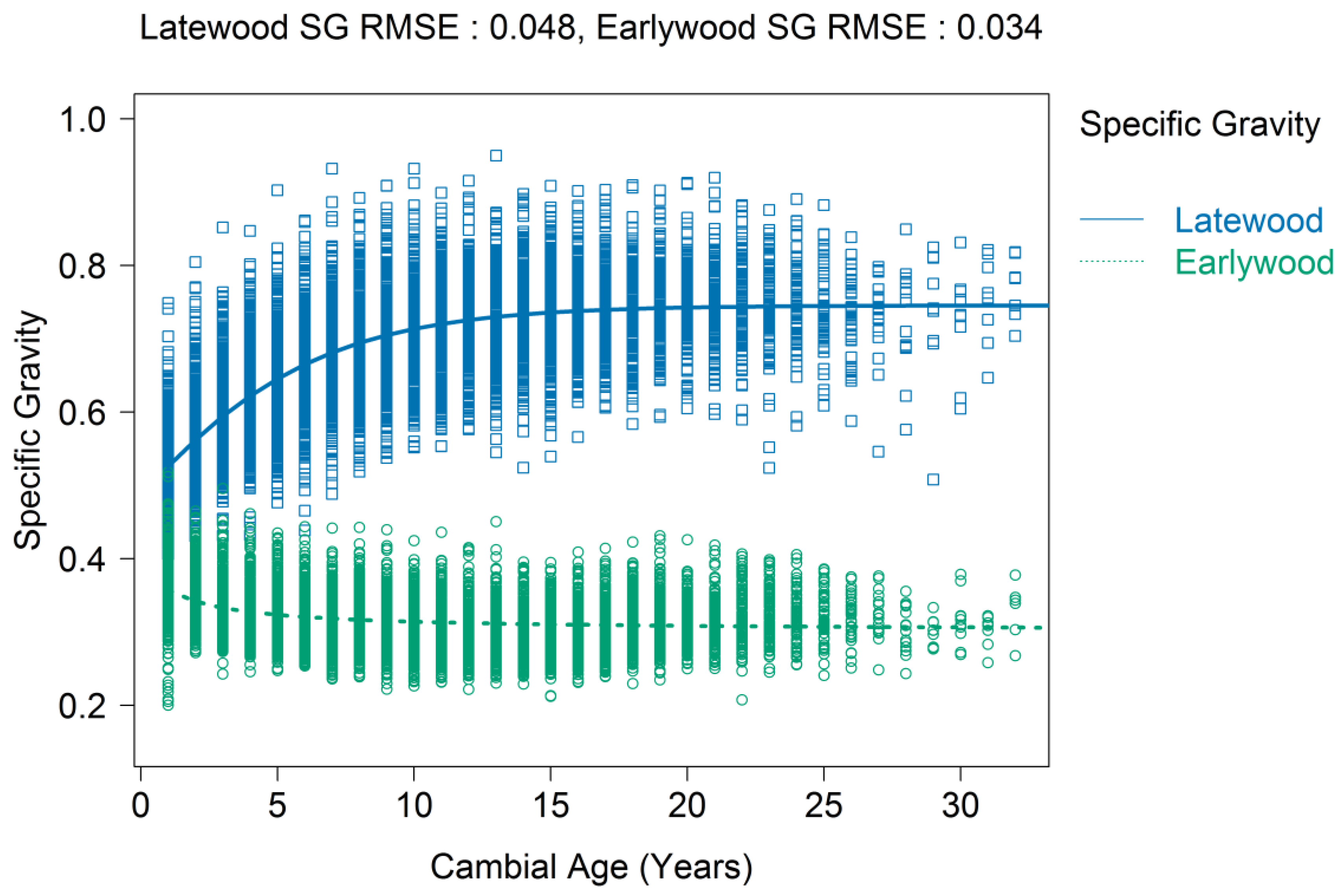
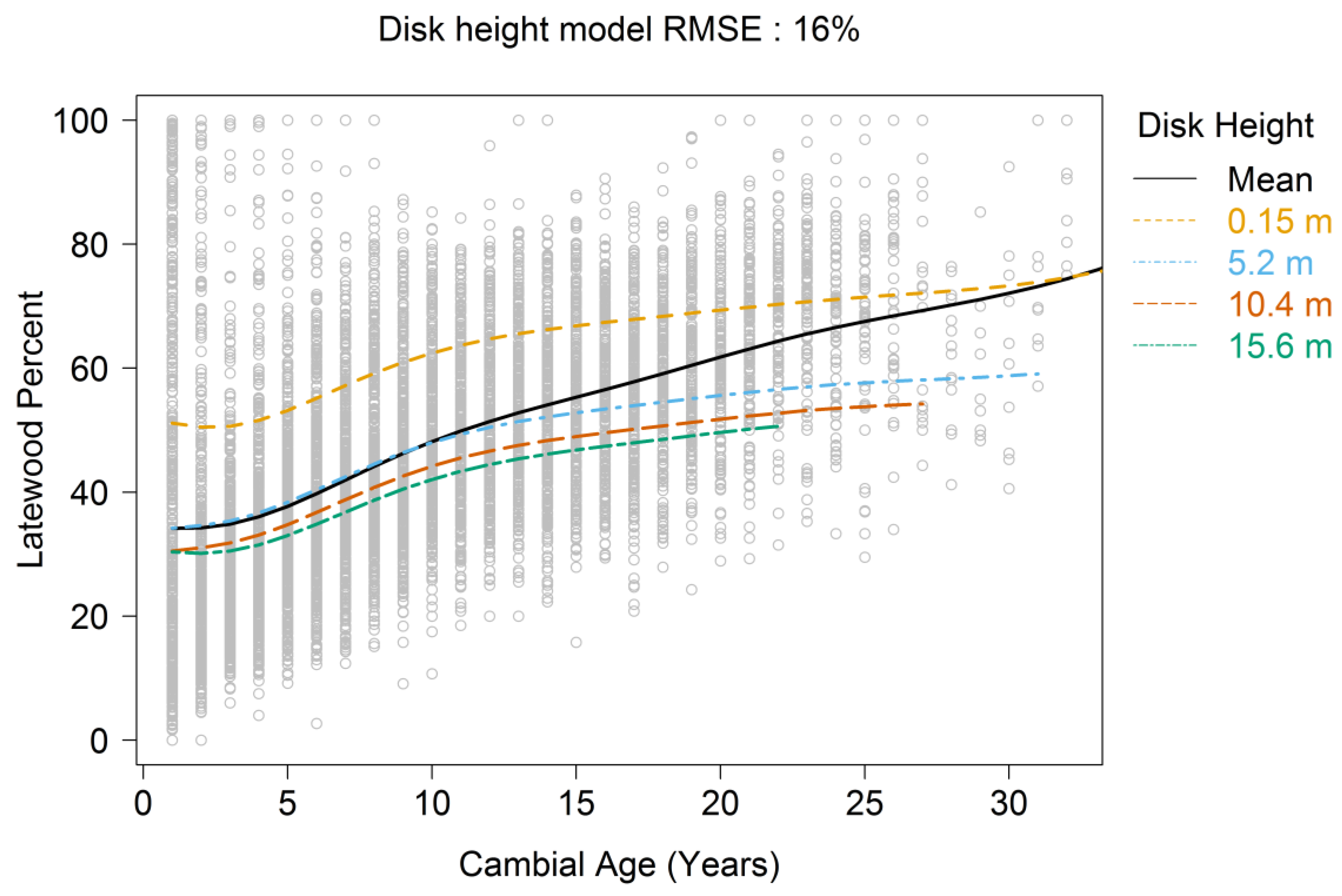
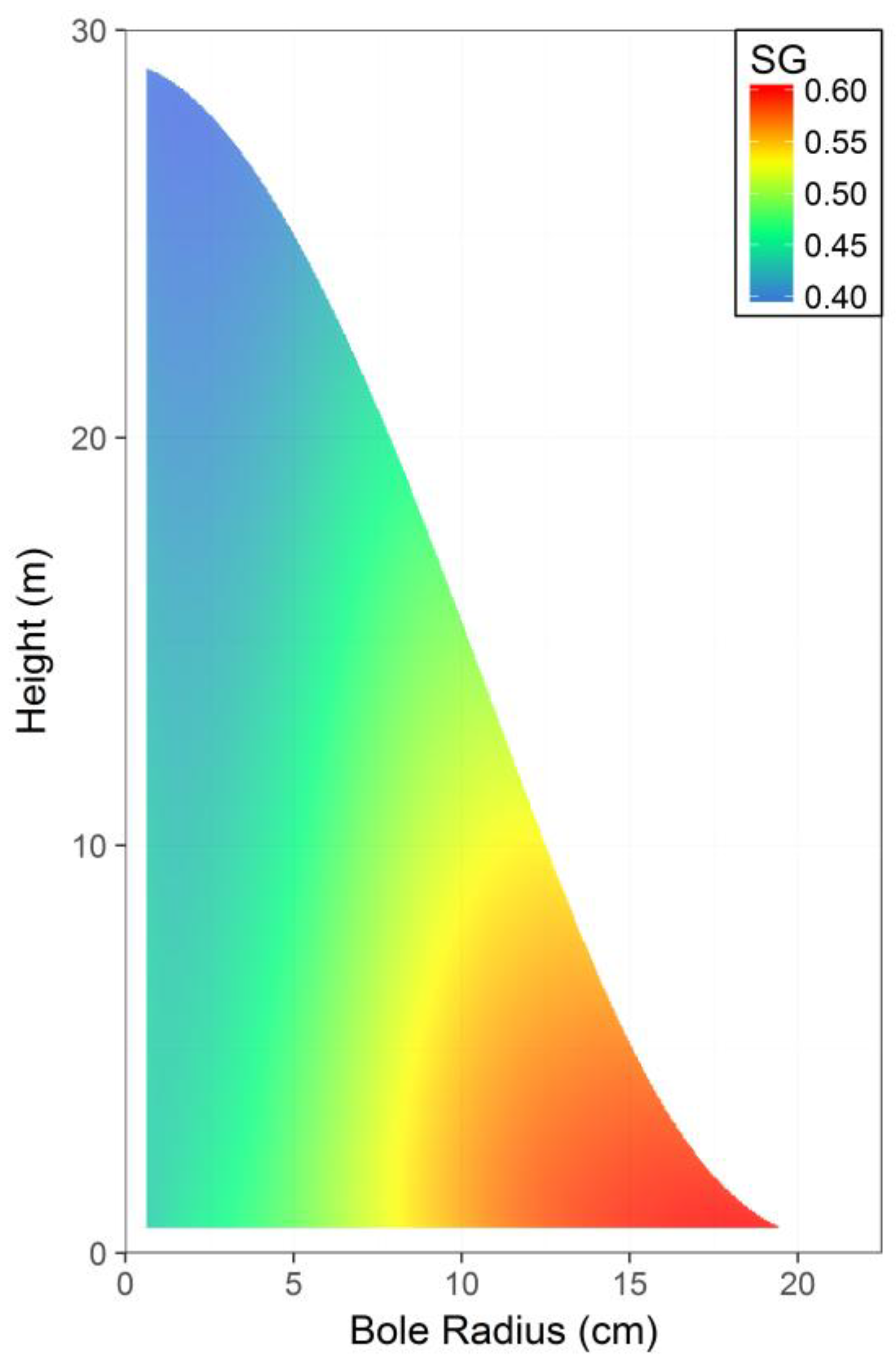
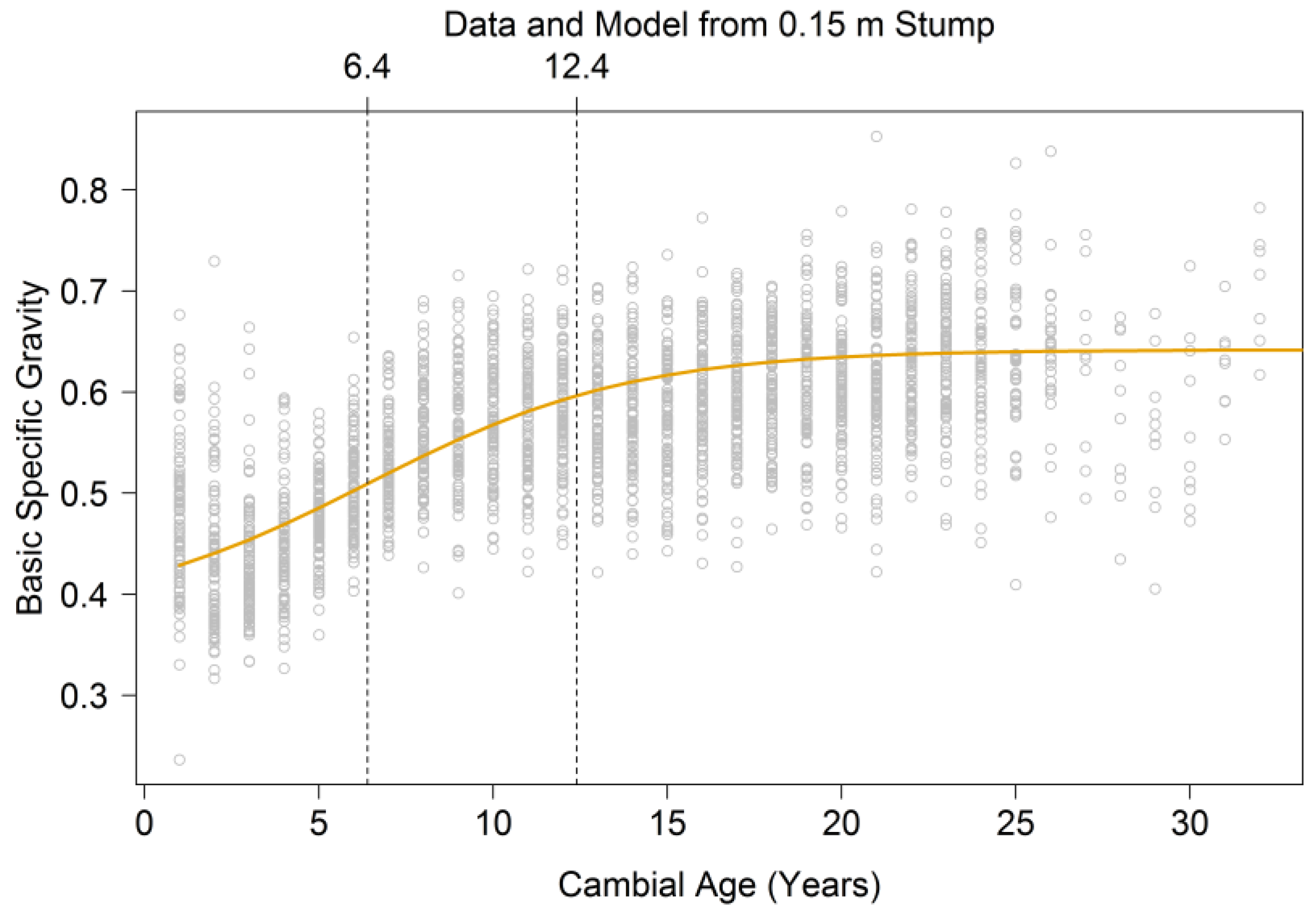
| Stand | Latitude | Longitude | Age | Site Index (m) | Trees Felled | Height (m) | DBH (cm) | First Thin 1 | Second Thin 1 | HWC 1 | First Fert 1 | Second Fert 1 |
|---|---|---|---|---|---|---|---|---|---|---|---|---|
| 1 | 31.118729 | −81.757379 | 24 | 27.4 | 20 | 27.3 | 30.6 | 20 | No | No | 12 | 20 |
| 2 | 31.408185 | −81.772966 | 25 | 27.1 | 21 | 27.3 | 30.9 | 15 | No | Yes | U 2 | U 2 |
| 3 | 31.189826 | −81.750544 | 26 | 25.6 | 21 | 27.1 | 31.7 | 15 | No | Yes | U 2 | U 2 |
| 4 | 31.322529 | −81.595399 | 27 | 26.2 | 21 | 25.7 | 30.9 | 21 | No | Yes | 12 | 19 |
| 5 | 31.344459 | −81.652424 | 33 | 25.3 | 10 | 27.5 | 33.0 | 16 | 27 | No | 11 | No |
| Property | Parameter 1 | Model | ||
|---|---|---|---|---|
| First | Second | Third | ||
| Ring SG | β0 | 0.355 | 0.377 | 0.414 |
| β1 | 0.643 | 0.611 | 0.630 | |
| β2 | 10.71 | 6.40 | 6.30 | |
| β3 | 7.28 | 3.81 | 4.45 | |
| β4 | −0.0072 | −0.0076 | ||
| β5 | −0.0038 | |||
| Ring Width | β0 | 106.12 | 108.64 | |
| β1 | 9.92 | 8.66 | ||
| β2 | −1.108 | |||
| Latewood SG | β1 | 0.745 | ||
| β2 | −2.515 | |||
| β3 | 4.03 | |||
| Earlywood SG | β0 | 0.302 | ||
| β1 | 0.466 | |||
| β2 | 1.764 | |||
| Latewood Percent | α0 | −2.542 | −2.542 | |
| α1 | −1.967 | −1.967 | ||
| β0 | −4.582 | −3.992 | ||
| β1 | −0.0543 | −0.0769 | ||
| β2 | −0.0527 | |||
| γ0 | −0.800 | −0.271 | ||
| γ1 | 0.0652 | 0.0480 | ||
| γ2 | −0.0416 | |||
| Property | Model | AIC 1 | Fit Indices (R2) | Model Errors 1 | ||||
|---|---|---|---|---|---|---|---|---|
| Fixed | Site | Tree | E | RMSE | |E|% | |||
| SG | 1 | −25873 | 0.45 | 0.48 | 0.54 | 0.0004 | 0.064 | 10.3 |
| 2 | −26494 | 0.55 | 0.58 | 0.64 | 0.0007 | 0.059 | 9.3 | |
| 3 | −26696 | 0.56 | 0.59 | 0.64 | 0.0007 | 0.058 | 9.1 | |
| Ring Width | 4 | 30592 | 0.44 | 0.45 | 0.46 | 0.1190 | 2.45 | 29.3 |
| 5 | 30477 | 0.46 | 0.46 | 0.47 | 0.1044 | 2.41 | 28.4 | |
| Latewood SG | 6 | −26529 | 0.54 | 0.55 | 0.61 | 0.004 | 0.048 | 7.1 |
| Earlywood SG | 7 | −36462 | 0.16 | 0.17 | 0.30 | 0.0001 | 0.034 | 8.2 |
| Product Class | Age | Height (m) | DBH (cm) | Property 1 | SG | ||||
|---|---|---|---|---|---|---|---|---|---|
| Tree | Log 1 | Log 2 | Log 3 | Tip | |||||
| Pulpwood | 10 | 13.2 | 15.4 | Volume (m3) | 0.117 | 0.081 | 0.032 | - | 0.004 |
| Wood SG | 0.471 | 0.484 | 0.445 | - | 0.401 | ||||
| Corewood% | 66 | 51 | 98 | - | 100 | ||||
| Outerwood% | 0 | 0 | 0 | - | 0 | ||||
| Chip-n-saw | 15 | 18.4 | 21.2 | Volume (m3) | 0.305 | 0.169 | 0.091 | - | 0.045 |
| SG | 0.491 | 0.52 | 0.468 | - | 0.426 | ||||
| Corewood% | 41 | 25 | 47 | - | 100 | ||||
| Outerwood% | 14 | 25 | 2 | - | 0 | ||||
| Sawtimber | 27 | 27.4 | 31.1 | Volume (m3) | 0.967 | 0.403 | 0.258 | 0.168 | 0.138 |
| SG | 0.514 | 0.557 | 0.515 | 0.476 | 0.428 | ||||
| Corewood% | 20 | 10 | 17 | 25 | 100 | ||||
| Outerwood% | 50 | 68 | 63 | 27 | 0 | ||||
| Sawtimber | 30 | 29.2 | 33.0 | Volume (m3) | 1.157 | 0.461 | 0.3 | 0.202 | 0.194 |
| SG | 0.516 | 0.562 | 0.522 | 0.482 | 0.431 | ||||
| Corewood% | 18 | 9 | 14 | 21 | 100 | ||||
| Outerwood% | 52 | 72 | 68 | 30 | 0 | ||||
© 2018 by the authors. Licensee MDPI, Basel, Switzerland. This article is an open access article distributed under the terms and conditions of the Creative Commons Attribution (CC BY) license (http://creativecommons.org/licenses/by/4.0/).
Share and Cite
Dahlen, J.; Auty, D.; Eberhardt, T.L. Models for Predicting Specific Gravity and Ring Width for Loblolly Pine from Intensively Managed Plantations, and Implications for Wood Utilization. Forests 2018, 9, 292. https://doi.org/10.3390/f9060292
Dahlen J, Auty D, Eberhardt TL. Models for Predicting Specific Gravity and Ring Width for Loblolly Pine from Intensively Managed Plantations, and Implications for Wood Utilization. Forests. 2018; 9(6):292. https://doi.org/10.3390/f9060292
Chicago/Turabian StyleDahlen, Joseph, David Auty, and Thomas L. Eberhardt. 2018. "Models for Predicting Specific Gravity and Ring Width for Loblolly Pine from Intensively Managed Plantations, and Implications for Wood Utilization" Forests 9, no. 6: 292. https://doi.org/10.3390/f9060292
APA StyleDahlen, J., Auty, D., & Eberhardt, T. L. (2018). Models for Predicting Specific Gravity and Ring Width for Loblolly Pine from Intensively Managed Plantations, and Implications for Wood Utilization. Forests, 9(6), 292. https://doi.org/10.3390/f9060292




